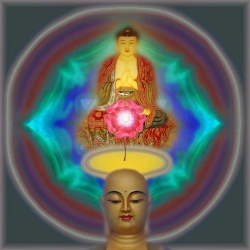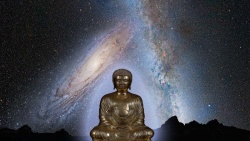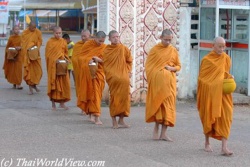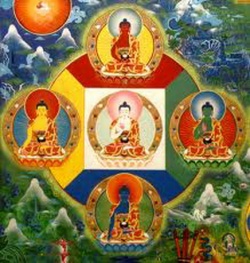Difference between revisions of "How to spot a good Buddhist teacher"
(Created page with "One set of meditation practices in the Buddhist tradition are the ‘Brahmaviharas’. This can be translated as ‘sublime abodes’ or ‘dwelling places of...") |
|||
| Line 1: | Line 1: | ||
| − | One set of [[meditation practices]] in the [[Buddhist tradition]] are the ‘[[Brahmaviharas]]’. This can be translated as ‘[[sublime abodes]]’ or | + | <nomobile>{{DisplayImages|4109|452|3656|2366|665}}</nomobile> |
| + | |||
| + | |||
| + | |||
| + | |||
| + | |||
| + | |||
| + | |||
| + | |||
| + | |||
| + | One set of [[meditation practices]] in the [[Buddhist tradition]] are the ‘[[Brahmaviharas]]’. This can be translated as ‘[[sublime abodes]]’ or ‘[[dwelling places of the gods]]’ or something like that. | ||
| Line 8: | Line 18: | ||
[[Karuna bhavana]] ([[cultivation]] of [[compassion]]) | [[Karuna bhavana]] ([[cultivation]] of [[compassion]]) | ||
[[Mudita bhavana]] ([[cultivation]] of [[sympathetic joy]]) | [[Mudita bhavana]] ([[cultivation]] of [[sympathetic joy]]) | ||
| − | + | [[Upekka bhavana]] ([[cultivation]] of [[equanimity]]) | |
</poem> | </poem> | ||
| Line 14: | Line 24: | ||
They’re all based on the first one – the [[cultivation]] of [[loving-kindness]]. It’s like the [[energy]] you need to do anything else. | They’re all based on the first one – the [[cultivation]] of [[loving-kindness]]. It’s like the [[energy]] you need to do anything else. | ||
| − | Once you’ve developed [[metta]] to some extent, it will naturally become [[compassion]] when you see [[people]] who are [[suffering]]. It will naturally become [[sympathetic joy]] when you see [[people]] who are having a good time. The practices are ways of further developing these natural {{Wiki|tendencies}}. | + | Once you’ve developed [[metta]] to some extent, it will naturally become [[compassion]] when you see [[people]] who are [[suffering]]. It will naturally become [[sympathetic joy]] when you see [[people]] who are having a good time. |
| + | |||
| + | The practices are ways of further developing these natural {{Wiki|tendencies}}. | ||
| + | |||
| + | |||
| + | [[Equanimity]] is a weird one that I don’t really have much of a first-hand [[feeling]] for. | ||
| + | |||
| + | As far as I can tell, once [[insight]] into [[the nature of reality]] kicks in, you will have an ‘[[equanimous]]’ response when faced with any situation. | ||
| + | |||
| + | Once there’s a real [[letting go]] (which is not the same as [[indifference]] and not the same as being blocked). So [[equanimity]] is what happens when [[metta]] meets [[reality]]. | ||
| + | |||
| + | |||
| − | |||
Is it [[wisdom]] or [[delusion]]? | Is it [[wisdom]] or [[delusion]]? | ||
| + | |||
| + | |||
Whenever I [[experience]] [[equanimity]], I’m always fairly suspicious. I’ve seen [[Buddhists]] get into a [[state]] of pseudo [[equanimity]] and pretend (even to themselves) they’ve got it sussed. | Whenever I [[experience]] [[equanimity]], I’m always fairly suspicious. I’ve seen [[Buddhists]] get into a [[state]] of pseudo [[equanimity]] and pretend (even to themselves) they’ve got it sussed. | ||
| Line 23: | Line 45: | ||
It looks cool in some people’s [[eyes]]. You can build a following of eager [[disciples]] out of this kind of [[delusion]]. There’s a kind of unruffled grace about it. | It looks cool in some people’s [[eyes]]. You can build a following of eager [[disciples]] out of this kind of [[delusion]]. There’s a kind of unruffled grace about it. | ||
| − | But after a few years of [[knowing]] this kind of [[teacher]], you realise that actually they’re just unwilling to [[feel]]. It’s too messy and it’s harder to stay in control. Your limbs flap about more. Your face gets into weird shapes ([[smiles]], frowns, etc). Not quite as beautiful to look at. From one {{Wiki|perspective}} anyway. And of course [[feeling]] involves [[feeling]] [[pain]] as well as all the good stuff. | + | But after a few years of [[knowing]] this kind of [[teacher]], you realise that actually they’re just unwilling to [[feel]]. It’s too messy and it’s harder to stay in control. |
| + | |||
| + | Your limbs flap about more. Your face gets into weird shapes ([[smiles]], frowns, etc). Not quite as beautiful to look at. From one {{Wiki|perspective}} anyway. | ||
| + | |||
| + | And of course [[feeling]] involves [[feeling]] [[pain]] as well as all the good stuff. | ||
What does a real [[Buddhist teacher]] look like? | What does a real [[Buddhist teacher]] look like? | ||
| − | |||
| − | + | It seems that in the [[west]] there’s this [[idea]] that [[Buddhists]] aren’t supposed to be ruffled. They are supposed to be on top of things. They’re supposed to breeze through dramas. | |
| − | But [[people]] who get into identifying with being ‘[[Buddhist]]’ can paint on something fairly similar and prance about pretending to be Obi-Wan Kenobe and lots of [[people]] won’t know the difference. Even the Obi-Wannabe might not know the difference. | + | I’m sure Hollywood’s got something to do with this. That bloke out of The [[Matrix]] is a good example. |
| + | |||
| + | |||
| + | |||
| + | |||
| + | There’s some [[truth]] to this. | ||
| + | |||
| + | |||
| + | |||
| + | [[Buddhist practice]] does increase your [[emotional]] stability. It does allow you to let go of needing things to be a certain way in order to [[feel]] well and [[happy]]. | ||
| + | |||
| + | And this allows you to be a bit more flexible with others and with changing situations. This can come across as unruffled. | ||
| + | |||
| + | But [[people]] who get into identifying with being ‘[[Buddhist]]’ can paint on something fairly similar and prance about pretending to be Obi-Wan Kenobe and lots of [[people]] won’t know the difference. | ||
| + | |||
| + | Even the Obi-Wannabe might not know the difference. | ||
| + | |||
| + | |||
| + | If you keep practising, however, eventually, [[reality]] bleeds through. All the [[feelings]] you’ve been ignoring for years find their way out, and you have to start being a real [[Buddhist]]. | ||
| + | |||
| + | Not just the shell of one. | ||
| + | |||
| + | And that could look like pretty much anything at all. | ||
| − | |||
Don’t [[judge]] a [[Buddhist]] [[book]] by its cover | Don’t [[judge]] a [[Buddhist]] [[book]] by its cover | ||
| − | |||
| − | Just because someone swears when they stub their toe, it doesn’t mean they’re a bad [[Buddhist teacher]] with no real [[wisdom]]. They’re probably more honest and spontaneous than someone who takes a deep [[breath]], [[smiles]] sweetly and walks away mindfully. | + | I guess what I’m saying is don’t [[judge]] a [[Buddhist]] [[book]] by its cover. If you’re looking for a [[teacher]], my advice is to go for someone down to [[Earth]] who doesn’t seem too exotic and trippy. |
| + | |||
| + | The exotic and trippy ones might be cool, but it’s harder to spot whether or not they are. | ||
| + | |||
| + | Just because someone swears when they stub their toe, it doesn’t mean they’re a bad [[Buddhist teacher]] with no real [[wisdom]]. | ||
| + | |||
| + | They’re probably more honest and spontaneous than someone who takes a deep [[breath]], [[smiles]] sweetly and walks away mindfully. | ||
| + | |||
| + | However, just because someone takes a deep [[breath]] and walks away mindfully, it doesn’t mean they’re a bad [[teacher]] either! | ||
| + | |||
| + | We all have our shortcomings. Just remember they’re all [[human]], they’re all not so different from you, and they’re all just trying to make some [[sense]] out of this crazy [[life]]. | ||
| − | + | And maybe within all that, they can help you out by introducing you to the [[path]] and walking alongside you for a while. | |
{{R}} | {{R}} | ||
http://www.mybuddhistlife.com/2012/10/how-to-spot-a-good-buddhist-teacher/ | http://www.mybuddhistlife.com/2012/10/how-to-spot-a-good-buddhist-teacher/ | ||
[[Category:Guru]] | [[Category:Guru]] | ||
Latest revision as of 10:27, 15 January 2016
One set of meditation practices in the Buddhist tradition are the ‘Brahmaviharas’. This can be translated as ‘sublime abodes’ or ‘dwelling places of the gods’ or something like that.
There are four practices:
Metta bhavana (cultivation of loving-kindness)
Karuna bhavana (cultivation of compassion)
Mudita bhavana (cultivation of sympathetic joy)
Upekka bhavana (cultivation of equanimity)
They’re all based on the first one – the cultivation of loving-kindness. It’s like the energy you need to do anything else.
Once you’ve developed metta to some extent, it will naturally become compassion when you see people who are suffering. It will naturally become sympathetic joy when you see people who are having a good time.
The practices are ways of further developing these natural tendencies.
Equanimity is a weird one that I don’t really have much of a first-hand feeling for.
As far as I can tell, once insight into the nature of reality kicks in, you will have an ‘equanimous’ response when faced with any situation.
Once there’s a real letting go (which is not the same as indifference and not the same as being blocked). So equanimity is what happens when metta meets reality.
Whenever I experience equanimity, I’m always fairly suspicious. I’ve seen Buddhists get into a state of pseudo equanimity and pretend (even to themselves) they’ve got it sussed.
It looks cool in some people’s eyes. You can build a following of eager disciples out of this kind of delusion. There’s a kind of unruffled grace about it.
But after a few years of knowing this kind of teacher, you realise that actually they’re just unwilling to feel. It’s too messy and it’s harder to stay in control.
Your limbs flap about more. Your face gets into weird shapes (smiles, frowns, etc). Not quite as beautiful to look at. From one perspective anyway.
And of course feeling involves feeling pain as well as all the good stuff. What does a real Buddhist teacher look like?
It seems that in the west there’s this idea that Buddhists aren’t supposed to be ruffled. They are supposed to be on top of things. They’re supposed to breeze through dramas.
I’m sure Hollywood’s got something to do with this. That bloke out of The Matrix is a good example.
There’s some truth to this.
Buddhist practice does increase your emotional stability. It does allow you to let go of needing things to be a certain way in order to feel well and happy.
And this allows you to be a bit more flexible with others and with changing situations. This can come across as unruffled.
But people who get into identifying with being ‘Buddhist’ can paint on something fairly similar and prance about pretending to be Obi-Wan Kenobe and lots of people won’t know the difference.
Even the Obi-Wannabe might not know the difference.
If you keep practising, however, eventually, reality bleeds through. All the feelings you’ve been ignoring for years find their way out, and you have to start being a real Buddhist.
Not just the shell of one.
And that could look like pretty much anything at all.
Don’t judge a Buddhist book by its cover
I guess what I’m saying is don’t judge a Buddhist book by its cover. If you’re looking for a teacher, my advice is to go for someone down to Earth who doesn’t seem too exotic and trippy.
The exotic and trippy ones might be cool, but it’s harder to spot whether or not they are.
Just because someone swears when they stub their toe, it doesn’t mean they’re a bad Buddhist teacher with no real wisdom.
They’re probably more honest and spontaneous than someone who takes a deep breath, smiles sweetly and walks away mindfully.
However, just because someone takes a deep breath and walks away mindfully, it doesn’t mean they’re a bad teacher either!
We all have our shortcomings. Just remember they’re all human, they’re all not so different from you, and they’re all just trying to make some sense out of this crazy life.
And maybe within all that, they can help you out by introducing you to the path and walking alongside you for a while.
Source
http://www.mybuddhistlife.com/2012/10/how-to-spot-a-good-buddhist-teacher/




